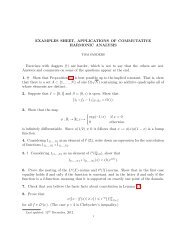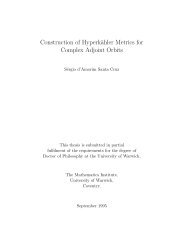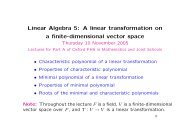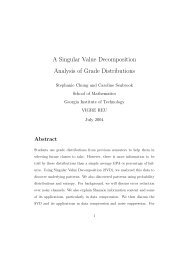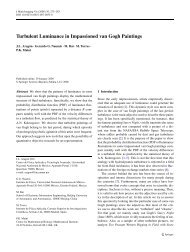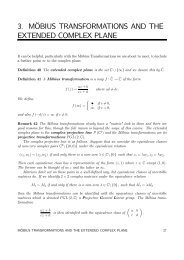Fourier Series and Partial Differential Equations Lecture Notes
Fourier Series and Partial Differential Equations Lecture Notes
Fourier Series and Partial Differential Equations Lecture Notes
You also want an ePaper? Increase the reach of your titles
YUMPU automatically turns print PDFs into web optimized ePapers that Google loves.
Chapter 3. The heat equation 29<br />
From equation (3.34) we see that<br />
T(x,0) =<br />
∞ <br />
nπx<br />
<br />
ansin . (3.36)<br />
L<br />
n=1<br />
Comparing terms we see that a1 = 1, a2 = 1/2 <strong>and</strong> an = 0 (n ≥ 3) so that the solution is<br />
<br />
πx<br />
<br />
T(x,t) = sin e<br />
L<br />
−π2κt/L2 + 1<br />
2 sin<br />
<br />
2πx<br />
e<br />
L<br />
−4π2κt/L2 . (3.37)<br />
3.4.1 Application of <strong>Fourier</strong> series<br />
To solve for more general initial conditions, we can use <strong>Fourier</strong> series to determine the<br />
constants an:<br />
∞ <br />
nπx<br />
<br />
T(x,0) = ansin , 0 ≤ x ≤ L.<br />
L<br />
(3.38)<br />
n=1<br />
The question is now, given f(x), can it be exp<strong>and</strong>ed as a <strong>Fourier</strong> sine series<br />
f(x) =<br />
∞ <br />
nπx<br />
<br />
ansin , 0 ≤ x ≤ L? (3.39)<br />
L<br />
n=1<br />
From the lectures on <strong>Fourier</strong> series, we know that such an expansion exists if e.g. f is<br />
piecewise continuously differentiable on [0,L]. The coefficients an are determined by the<br />
orthogonality relations:<br />
Thus<br />
<br />
L <br />
mπx<br />
<br />
nπx<br />
<br />
sin sin dx =<br />
L L<br />
0<br />
0<br />
0, m = n,<br />
L, m = n.<br />
1<br />
2<br />
(3.40)<br />
an = 2<br />
L <br />
nπx<br />
<br />
f(x)sin dx. (3.41)<br />
L L<br />
Example 3.2 Find the solution of the IBVP when<br />
<br />
0 for 0 ≤ x ≤ L1 <strong>and</strong> L2 ≤ x ≤ L,<br />
f(x) =<br />
1 for L1 < x < L2.<br />
Here f(x) has the <strong>Fourier</strong> sine expansion<br />
2<br />
π<br />
∞<br />
n=1<br />
<strong>and</strong> the solution of IBVP is<br />
T(x,t) = 2<br />
π<br />
∞<br />
n=1<br />
1<br />
n<br />
<br />
1<br />
cos<br />
n<br />
<br />
cos<br />
<br />
nπL1<br />
−cos<br />
L<br />
<br />
nπL1<br />
−cos<br />
L<br />
<br />
nπL2<br />
sin<br />
L<br />
<br />
nπL2<br />
sin<br />
L<br />
(3.42)<br />
<br />
nπx<br />
<br />
, (3.43)<br />
L<br />
<br />
nπx<br />
<br />
e<br />
L<br />
−n2π2κt/L2 . (3.44)




